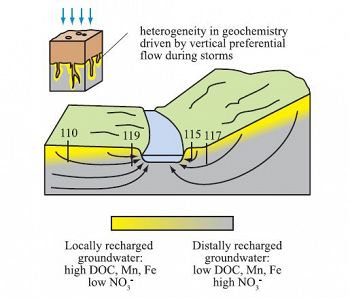Sawyer et al., 2014
Hydrologic dynamics and geochemical responses within a floodplain aquifer and hyporheic zone during Hurricane Sandy
Sawyer, A.H., L.A. Kaplan, O. Lazareva, and H.A. Michael (2014)
Water Resources Research, 50 (6): 4877–4892
-
Christina, COLLABORATOR
-
Christina, INVESTIGATOR
-
Christina, COLLABORATOR
-
Christina, INVESTIGATOR
Abstract
Under base flow conditions, topographic controls on recharge locations and groundwater residence times dictate patterns in redox-sensitive solutes. During storms, vertical preferential flow paths such as macropores accommodate rapid fluid and solute transport (zoomed view), which drives heterogeneity in water chemistry and may promote hot spots in biogeochemical activity.
Storms dominate solute export budgets from catchments and drive hydrogeochemical changes in the near-stream environment. We captured near-stream hydrogeochemical dynamics during an intense storm (Hurricane Sandy, October 2012), by instrumenting a riparian-hyporheic zone transect of White Clay Creek in the Christina River Basin Critical Zone Observatory with pressure transducers, redox probes, and pore water samplers.
In the floodplain aquifer, preferential vertical flow paths such as macropores facilitated rapid infiltration early in the storm. Water table rose quickly and promoted continuous groundwater discharge to the stream. Floodplain-hillslope topography controlled poststorm aquifer drainage rates, as the broad, western floodplain aquifer drained more slowly than the narrow, eastern floodplain aquifer adjacent to a steep hillslope.
These changes in groundwater flow drove heterogeneous geochemical responses in the floodplain aquifer and hyporheic zone. Vertical infiltration in the floodplain and hyporheic exchange in the streambed increased DOC and oxygen delivery to microbially active sediments, which may have enhanced respiration. Resulting geochemical perturbations persisted from days to weeks after the storm.
Our observations suggest that groundwater-borne solute delivery to streams during storms depends on unique interactions of vertical infiltration along preferential pathways, perturbations to groundwater geochemistry, and topographically controlled drainage rates.
Citation
Sawyer, A.H., L.A. Kaplan, O. Lazareva, and H.A. Michael (2014): Hydrologic dynamics and geochemical responses within a floodplain aquifer and hyporheic zone during Hurricane Sandy. Water Resources Research, 50 (6): 4877–4892. DOI: 10.1002/2013WR015101
 This Paper/Book acknowledges NSF CZO grant support.
This Paper/Book acknowledges NSF CZO grant support.
Explore Further





